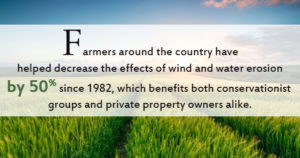Few resources on this planet today are more important than the land itself. As populations and commercial businesses continue to grow, protecting large property ranch estates is important for the conservation of U.S. water, wildlife, and wilderness spaces. That’s one reason why conservation easements were first established hundreds of years ago and continue to be effective today. Learn more about how conservation easements work and their benefits for governments and landowners alike.
What is a conservation easement?
A conservation easement is a voluntary donation or sale of private property to a government agency that allows the resources of the land to receive federal protection from further developments. The public benefits of the land — such as water access, wildlife habitation, farm and ranch property rights, outdoor recreation uses, etc. — are safeguarded against future subdivisions or developments for as long as the property remains privately owned.
What are the benefits of conservation easements for landowners?
Conservation easements give private property owners a generous estate tax incentive, which allows land to be passed from generation to generation fully intact. Sometimes, the prohibitive cost of estate taxes can cause parts of ranch estates to be subdivided and sold off — but with an easement, property heirs can exclude up to 40% or $500,000 worth of land from their tax claims.
What does the government get in return?
Every conservation easement is created on terms and agreements specific to the land itself. For example, a ranch with land bordering a national or state park can serve as a “buffer” zone for the migrating wildlife that roams the area. A lakefront property, on the other hand, might benefit from an easement that allows for water preservation or fishing tourism.

Will a conservation easement limit what I can do with my land?
In some ways, yes. Since the goal is to protect natural spaces, subdivisions and multi-housing developments are usually not permitted. However, farming and ranching are not only allowed, but encouraged. In fact, the careful stewardship of farmers around the country has helped decrease the effects of wind and water erosion by 50% since 1982, which benefits both conservationist groups and private property owners alike.
Conservation easements are one of the longest-running and most effective tools for preserving large ranch estates so that future generations can enjoy the natural beauty and splendor of the land. Learn more about how your property may qualify by speaking with a land trust or real estate agent familiar with ranching, farming, and recreational property estates.
